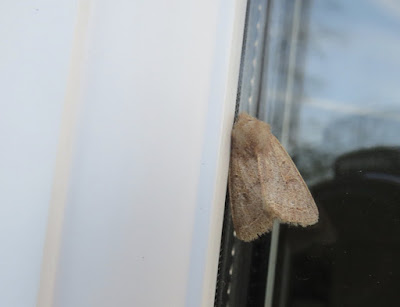With the weather warming up rapidly, I decided to dedicate the day to the garden and more particularly to the insects therein.
The moth trap was emptied very slowly from about 07.00am to about 09.00am. It contained numerous insects which were new to me, and some of my identifications are currently on the tentative side. However, stop press, I am now amending a couple of things because my moth guru, John Sirrett, has replied to my email and has corrected one of my identifications and suggested a solution to the one that had me stumped.
The first moth seen was actually resting on the door of the utility room. After much deliberation I decided it was a
Small Quaker. I tried photographing it against the life-size illustration in Waring et al as well as on the door.
 |
| Small Quaker |
Assuming I have got them right, I counted nine Small Quakers and 16 Common Quakers in and around the trap this morning.
 |
| Common Quaker |
 |
| Small Quaker on the left and Common Quaker on the right |
Another species of Quaker in the trap was much more distinctive; a
Twin-spot Quaker.
 |
| Twin-spot Quaker |
What I was really hoping for was something big and impressive. Two species fitted the bill, a
Brindled Beauty and an
Early Thorn.
 |
| Brindled Beauty |
 |
| Early Thorn |
In contrast, I rather dread looking at Pugs. I duly found four of them. One was quite easy, the
V-Pug. The other three were much harder. Two were larger than the third. I eventually decided the bigger ones were
Mottled Brindled Pug, and the smaller one a darker than normal Double-striped Pug.
 |
| Brindled Pug on the left and double-striped Pug on the right |
 |
| V-Pug |
Two easier ones next.
 |
| Hebrew Character |
 |
| Twenty-plumed Moth |
I saw four of the former and only one of the latter. Thankfully there weren't many micros (like the Twenty-plumed), but I did get one which I thought would be distinctive enough to identify.
 |
| Small March Moth |
I was mistaken. I think its some kind of pyralid sp, but I haven't come up with anything yet. In fact it was a micro, but not a Pyralid sp. It was a Small March Moth
Diurnea fagella. John somehow managed to identify it on the basis of a photograph attachment that wouldn't enlarge. Impressive.
A couple of caddis flies also caused confusion as I at first thought they were some kind of giant micro-moths before the penny dropped. I may even have discovered their specific names.
 |
| Stenophylax permistus |
 |
| Brachycentrus subnubilus |
The very first insect to exit the trap, somewhat to my relief, was a wasp sp. I spent much of the afternoon trying to identify and photograph bees.
 |
| Tawny Mining Bee |
 |
| Red Mason Bee |
When we got back from Castle we realised there was a bee in the downstairs loo. I caught it, and identified it as a Grey-patched Mining Bee.
 |
| Grey-patched Mining Bee |
No birds of note unless you count a Lesser Whitethroat heard from Castle Nurseries where Lyn and I were buying plants.

















No comments:
Post a Comment